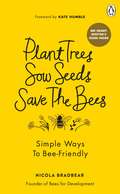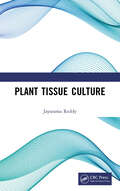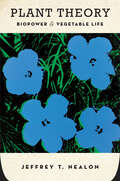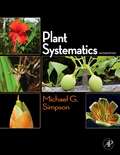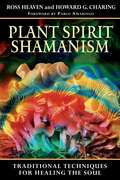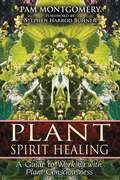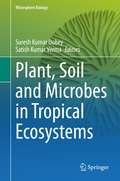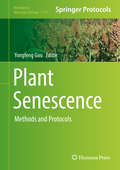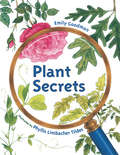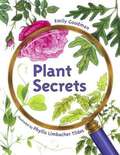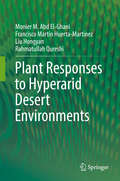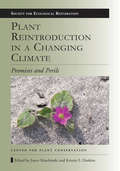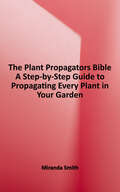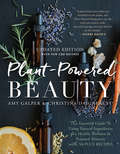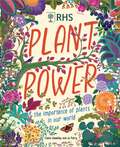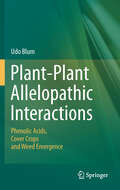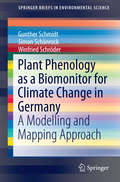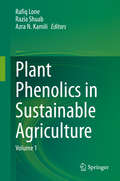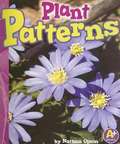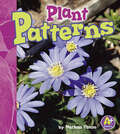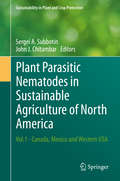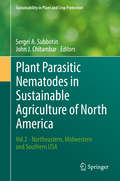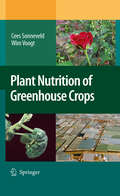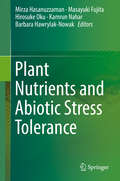- Table View
- List View
Plant Trees, Sow Seeds, Save The Bees: Simple ways to bee-friendly
by Nicola BradbearDiscover the wonder of bees (and other stripey insects) and how to help them survive. In this little book of bees, wasps, hoverflies and more, discover the easy ways to make your gardens, window boxes and pots insect havens. Rewild your garden with plants for bees and honeybees - simple acts of kindness to save the planet. Expert Nicola Bradbear, from Bees for Development charity, shows you how and why it's so important.There are lots of fun things you can do to make a big difference.With every book sold, proceeds will be donated to Bees for Development (www.beesfordevelopment.org)
Plant Tissue Culture
by Jayarama ReddyThis book is a comprehensive text on plant tissue culture, with its past, present, and future prospects and techniques discussed in detail. In the first three chapters, the history, terminologies, and applications are given in detail. The fourth chapter is dedicated to the instrumentation of plant tissue culture. The basic techniques used in PTC are described in the sixth chapter. The details of the constituents and types of different nutrient media are discussed in the eighth chapter. In chapter number 9, methods of haploid production have been described. Bioreactors are the instruments that are used for the large-scale production of plantlets and plant products. This book is useful for all the students, researchers, teachers, and industrialists interested in plant tissue culture. Print edition not for sale in india. This book is a comprehensive text on plant tissue culture, with its past, present, and future prospects and techniques discussed in detail.
Plant Theory
by Jeffrey NealonIn our age of ecological disaster, this book joins the growing philosophical literature on vegetable life to ask how our present debates about biopower and animal studies change if we take plants as a linchpin for thinking about biopolitics. Logically enough, the book uses animal studies as a way into the subject, but it does so in unexpected ways. Upending critical approaches of biopolitical regimes, it argues that it is plants rather than animals that are the forgotten and abjected forms of life under humanist biopower. Indeed, biopolitical theory has consistently sidestepped the issue of vegetable life, and more recently, has been outright hostile to it. Provocatively, Jeffrey T. Nealon wonders whether animal studies, which has taken the "inventor" of biopower himself to task for speciesism, has not misread Foucault, thereby managing to extend humanist biopower rather than to curb its reach. Nealon is interested in how and why this is the case. Plant Theory turns to several other thinkers of the high theory generation in an effort to imagine new futures for the ongoing biopolitical debate.
Plant Systematics
by Michael G. SimpsonPlant Systematics has made a substantial contribution to plant systematics courses at the upper-undergraduate and first year graduate level. This second edition continues to provide the basis for teaching an introduction to the morphology, evolution, and classification of land plants. A foundation of the approach, methods, research goals, evidence, and terminology of plant systematics are presented along with the most recent knowledge of evolutionary relationships of plants and practical information vital to the field. In this second edition, the author includes greatly expanded treatments of families of lycophytes, ferns, gymnosperms, and flowering plants (all with full-color plates), a new chapter on species concepts and the role of systematics in conservation biology, and a new appendix summarizing basic statistical and morphometric techniques used in plant systematics studies. An explanation of maximum likelihood and Bayesian inference algorithms is included in methods of phylogenetic inference, and chapters on morphology and plant nomenclature have been augmented with new material.
Plant Spirit Shamanism: Traditional Techniques for Healing the Soul
by Howard G. Charing Pablo Amaringo Ross HeavenAn in-depth look at the role of plant spirits in shamanic rituals from around the world • Shows how shamans heal using their knowledge of plant spirits as well as the plant’s “medical properties” • Explores the core methods of plant shamanism--soul retrieval, spirit extraction, and sin eating--and includes techniques for connecting with plant spirits • Includes extensive field interviews with master shamans of all traditions In Plant Spirit Shamanism, Ross Heaven and Howard G. Charing explore the use of one of the major allies of shamans for healing, seeing, dreaming, and empowerment--plant spirits. After observing great similarities in the use of plants among shamans throughout the world, they discovered the reason behind these similarities: Rather than dealing with the “medical properties” of the plants or specific healing techniques, shamans commune with the spirits of the plants themselves. From their years of in-depth shamanic work in the Amazon, Haiti, and Europe, including extensive field interviews with master shamans, Heaven and Charing present the core methods of plant shamanism used in healing rituals the world over: soul retrieval, spirit extraction, sin eating, and the Amazonian tradition of pusanga (love medicine). They explain the techniques shamans use to establish connections to plant spirits and provide practical exercises as well as a directory of traditional Amazonian and Caribbean healing plants and their common North American equivalents so readers can ex-plore the world of plant spirits and make allies of their own.
Plant Spirit Healing: A Guide to Working with Plant Consciousness
by Pam Montgomery Stephen Harrod BuhnerA hands-on approach to working with the healing powers of plant spirits • Explores the scientific basis underlying the practices of indigenous healers and shamans • Illuminates the matrix where plant intelligence and human intelligence join • Reveals that partnering with plants is an evolutionary imperative Indigenous healers and shamans have known since antiquity that plants possess a spirit essence that can communicate through light, sound, and vibration. Now scientific studies are verifying this understanding. Plant Spirit Healing reveals the power of plant spirits to join with human intelligence to bring about profound healing. These spirits take us beyond mere symptomatic treatment to aligning us with the vast web of nature. Plants are more than their chemical constituents. They are intelligent beings that have the capacity to raise consciousness to a level where true healing can take place.In this book, herbalist Pam Montgomery offers an understanding of the origins of disease and the therapeutic use of plant spirits to bring balance and healing. She offers a process engaging heart, soul, and spirit that she calls the triple spiral path. In our modern existence, we are increasingly challenged with broken hearts, souls in exile, and malnourished spirits. By working through the heart, we connect with the soul and gain access to spirit. She explains that the evolution of plants has always preceded their animal counterparts and that plant spirits offer a guide to our spiritual evolution--a stage of growth imperative not only for the healing of humans but also the healing of the earth.
Plant, Soil and Microbes in Tropical Ecosystems (Rhizosphere Biology)
by Satish Kumar Verma Suresh Kumar DubeyThis book describes the multitude of interactions between plant, soil, and micro-organisms. It emphasizes on how growth and development in plants, starting from seed germination, is heavily influenced by the soil type. It describes the interactions established by plants with soil and inhabitant microbial community. The chapters describe how plants selectively promote certain microorganisms in the rhizospheric ecozone to derive multifarious benefits such as nutrient acquisition and protection from diseases. The diversity of these rhizospheric microbes and their interactions with plants largely depend on plant genotype, soils attributes, and several abiotic and biotic factors. Most of the studies concerned with plant–microbe interaction are focused on temperate regions, even though the tropical ecosystems are more diverse and need more attention. Therefore, it is crucial to understand how soil type and climatic conditions influence the plant–soil–microbes interaction in the tropics. Considering the significance of the subject, the present volume is designed to cover the most relevant aspects of rhizospheric microbial interactions in tropical ecosystems. Chapters include aspects related to the diversity of rhizospheric microbes, as well as modern tools and techniques to assess the rhizospheric microbiomes and their functional roles. The book also covers applications of rhizospheric microbes and evaluation of prospects improving agricultural practice and productivity through the use of microbiome technologies. This book will be extremely interesting to microbiologists, plant biologists, and ecologists.
Plant Signals: How and Why Plants Communicate (Fountas & Pinnell Classroom, Guided Reading Grade 6)
by Corey FlanniganMysterious Communications When hiking in a forest, we admire a redwood's beauty or a pine tree's fragrance. But what we don't notice are the trees' hidden talents. Trees and other plants can actually communicate with one another in surprising ways—and for fascinating reasons. NIMAC-sourced textbook
Plant Senescence
by Yongfeng GuoThis detailed volume covers a wide variety of techniques either developed specially for plant senescence studies or optimized for studying senescing plants. After an introduction to the topic, the book continues with sections on phenotypic analysis and molecular markers of plant organ senescence, hormonal control of plant senescence, stress-induced senescence, molecular and cellular processes in plant senescence, as well as systems biology approaches. Written for the highly successful Methods in Molecular Biology series format, chapters include introductions to their respective topics, lists of the necessary materials and reagents, step-by-step, readily reproducible laboratory protocols, and tips on troubleshooting and avoiding known pitfalls. Authoritative and practical, Plant Senescence: Methods and Protocols aims to provide a useful hand book of standard protocols for plant molecular biologists working on senescence.
Plant Secrets
by Emily GoodmanYoung scientists will love this nature mystery that reveals the secrets hiding in seeds, plants, flowers, and fruits throughout the life cycle of various flora. Curiosity will bloom in this introduction to botany and primary nature science. Plants come in all shapes and sizes, but they go through the same stages as they grow. Using four common plants, young readers learn about plant structure and life cycle. Simple text and colorful, detailed illustrations show the major phases of plant growth with each stage holding a &“secret&” for curious readers to guess. Back matter offers more information on each plant, as well as greater detail on each stage of growth.
Plant Secrets
by Emily Goodman Phyllis Limbacher TildesPlants come in all shapes and sizes, but they go through the same stages as they grow. Using four common plants, young readers learn about a plant's life cycles.
Plant Responses to Hyperarid Desert Environments
by Monier M. Abd El-Ghani Francisco Martín Huerta-Martínez Liu Hongyan Rahmatullah QureshiThis book provides a comprehensive discussion on plant responses in hyperarid regions of Egypt, China, Mexico, and Pakistan. It describes their location, physiographic features, accidental vegetation along two transects, endangered vegetation species, human impact, and variety of plant types (e. g. climbing, succulent, and parasitic). Studies on biotic and abiotic interactions, plant biodiversity, and soil-plant relationships are also covered. Covering a wide range of plant conditions and adaptations, this book analyzes what happens when plants must endure very high temperatures and aridity. Plants have adapted by evolving their physical structure to store and conserve water. Examples are the absence of leaves which reduces transpiration and the growth of extremely long roots, allowing them to acquire moisture at, or near the water table. Plants in hyperarid habitats have also made behavioral adaptations in order to survive by synchronizing with the seasons of greatest moisture and/or coolest temperatures. For example, desert perennials remain dormant during dry periods of the year, then spring to life when water becomes available. The book includes many color illustrations, and has extensive and up-to-date references for further reading.
Plant Reintroduction in a Changing Climate: Promises and Perils (Science Practice Ecological Restoration)
by Kristin E. Haskins Joyce MaschinskiThis volume presents a comprehensive review of reintroduction projects and practices, the circumstances of their successes or failures, lessons learned, and the potential role for reintroductions in preserving species threatened by climate change. Contributors examine current plant reintroduction practices, from selecting appropriate source material and recipient sites to assessing population demography. The findings culminate in a set of Best Reintroduction Practice Guidelines, included in an appendix to the book. These guidelines cover stages from planning and implementation to long-term monitoring, and offer not only recommended actions but also checklists of questions to consider that are applicable to projects around the world. Plant Reintroduction in a Changing Climate is a comprehensive and accessible reference for practitioners to use in planning and executing rare plant reintroductions.
The Plant Propagator's Bible: A Step-by-Step Guide to Propagating Every Plant in Your Garden
by Miranda SmithThe Plant Propagator's Bible offers all you need to know to propagate new plants from existing ones.
Plant-Powered Beauty, Updated Edition: The Essential Guide to Using Natural Ingredients for Health, Wellness, and Personal Skincare (with 50-plus Recipes)
by Amy Galper Christina DaigneaultYou know your diet should be rich in plants for optimal health. So shouldn't the products you apply to your skin, which are absorbed into your body, also be filled with plants? If you've ever looked at the back of your so-called "natural" facial moisturizer or body cream and seen a list of complicated additives you couldn't recognize or pronounce, then you know firsthand that mass-produced synthetic beauty products can be something of a mystery. With Plant-Powered Beauty: The Essential Guide to Using Natural Ingredients for Health, Wellness, and Personal Skincare (with 50-plus Recipes), harness the power of plant-based energy to maintain your natural beauty and let your skin glow like never before. Natural beauty experts Amy Galper and Christina Daigneault show readers how to deconstruct beauty labels, parse ingredients lists, make informed choices about the products they use—and, most important, better understand how their skin works. At the heart of Plant-Powered Beauty, you will find more than 50 easy-to-follow recipes to make your own plant-based skincare and beauty products, such as: • Almond Milk Facial Cleanser • Anti-aging Facial Scrub • Blemish Gel • Choc-o-Mint Lip Balm • Coconut Whip Makeup Remover • Vitamin-Rich Hair Health Serum • Quick and Fresh Cucumber-Thyme Body Scrub • Moisturizing Body Oil for Super-Dry Skin • Natural Mouthwash Plus, in this updated edition of Plant-Powered Beauty, meet the hottest wellness and beauty ingredient: cannabidiol, a very unique molecule within the Cannabis sativa plant. Research shows that CBD has a remarkable effect on the skin, including supporting tissue repair, evening skin tone, and promoting a youthful glow. New CBD recipes—for men and women!—include a salve to reduce pain, bath soak to address inflammation, facial serum for balancing, roll-on for stress relief, body butter, and more. Plant-Powered Beauty unlocks sought-after wisdom for all aspects of plant-based personal skincare and celebrates the shift in beauty trends, bringing us back to natural beauty and reconnecting us with plants and healthy choices.
Plant Power: The Importance of Plants in our World
by Claire LlewellynPlants are amazing! They are found in every part of the world, growing from tiny seeds into beautiful blooms, gigantic trees and the delicious fruit and vegetables we eat. Plants are vitally important to humans, animals and even the climate, providing food, shelter, medicines and even helping to clean our planet's air and water. This book tells you everything you need to know about plants, from how they grow, reproduce and make their own food to the variety of ways that humans and animals use plants every single day.Readers can find out about plant parts and plant life cycles, pollination, food chains, photosynthesis, seeds and plant uses, such as in food, homes, furniture, musical instruments and medicines. We find out how plants can inspire us and how we need to protect plants so they can help protect us.This book is perfect for children aged 7+.
Plant-Plant Allelopathic Interactions: Phenolic Acids, Cover Crops and Weed Emergence
by Udo BlumIn an effort to implement conservation measures farmers have used a variety of production methods, including the use of reduced or zero tillage and cover crops. One benefit of these production methods has been early season weed control. The literature suggests that a variety of mechanisms may be involved, among them the allelopathic effects of phenolic acids. This retrospective analysis addresses the following: How likely are phenolic acid concentrations and environmental conditions in wheat no-till cropping systems for the inhibition of annual broadleaf weed emergence? and Do phenolic acids have a dominant role or are they just one component of a larger promoter/modifier/inhibitor complex? The book covers allelopathic plant-plant interactions, laboratory and field experiments, and future research. It uses a journal format, provides justifications for procedures used, if-then hypotheses, and cons and pros so that readers can reach their own conclusions.
Plant Phenology as a Biomonitor for Climate Change in Germany
by Gunther Schmidt Simon Schönrock Winfried SchröderThe investigations refer to the development of plant phenology since the 1960s in Germany. Spatiotemporal trends were assessed by means of regression kriging. It could be shown that there already is a distinct shift of phenological onset towards the beginning of the year of up to two weeks. In future, a shift of up to one month was calculated till 2080. Moreover, a prolongation of the vegetation period of up to three weeks was found. The findings are relevant for the development of mitigation measures to prevent from environmental, agricultural and economic issues due to climate change.
Plant Phenolics in Sustainable Agriculture: Volume 1
by Rafiq Lone Razia Shuab Azra N. KamiliThis book presents the latest research on plant phenolics, offering readers a detailed, yet comprehensive account of their role in sustainable agriculture. It covers a diverse range of topics, including extraction processes; the role of plant phenolics in growth and development; plant physiology; post-harvesting technologies; food preservation; environmental, biotic and abiotic stress; as well as nutrition and health. Further the book provides readers with an up-to-date review of this dynamic field and sets the direction for future research. Based on the authors’ extensive experience and written in an engaging style, this highly readable book will appeal to scholars from various disciplines. Bringing together work from leading international researchers, it is also a valuable reference resource for academics, researchers, students and teachers wanting to gain insights into the role of plant phenolics in sustainable agriculture.
Plant Patterns (Finding Patterns Ser.)
by Nathan OlsonSimple text introduce different kinds of plant patterns.
Plant Parasitic Nematodes in Sustainable Agriculture of North America: Vol. 1 - Canada, Mexico And Western Usa (Sustainability In Plant And Crop Protection Ser.)
by Sergei A. Subbotin John J. ChitambarPlant-parasitic nematodes are recognized as one of the greatest threats to crop production throughout the world. Estimated annual crop losses of $8 billion in the United States and $78 billion worldwide are attributed to plant parasitic nematodes. Plant parasitic nematodes not only cause damage individually but form disease-complexes with other microorganisms thereby increasing crop loss. Nematode diseases of crops are difficult to control because of their insidious nature and lack of specific diagnostic symptoms which closely resemble those caused by other plant pathogens and abiotic diseases. Future developments of sustainable management systems for preventing major economical agricultural losses due to nematodes is focused on strategies that limit production costs, enhance crop yields, and protect the environment. This book presents a first compendium and overview for nematode problems and their management across North America. Each chapter provides essential information on the occurrence and distribution of plant parasitic nematodes, their major crop hosts, impact on crop production and sustainable management strategies for each region of the continent including, Canada, Mexico and all states of the USA. For each region, a thematic overview of changes in crop production affected by plant parasitic nematodes and their management strategies over time will provide invaluable information on the important role of plant parasitic nematodes in sustainable agriculture.
Plant Parasitic Nematodes in Sustainable Agriculture of North America: Vol. 1 - Canada, Mexico And Western Usa (Sustainability In Plant And Crop Protection Ser.)
by Sergei A. Subbotin John J. ChitambarPlant-parasitic nematodes are recognized as one of the greatest threats to crop production throughout the world. Estimated annual crop losses of $8 billion in the United States and $78 billion worldwide are attributed to plant parasitic nematodes. Plant parasitic nematodes not only cause damage individually but form disease-complexes with other microorganisms thereby increasing crop loss. Nematode diseases of crops are difficult to control because of their insidious nature and lack of specific diagnostic symptoms which closely resemble those caused by other plant pathogens and abiotic diseases. Future developments of sustainable management systems for preventing major economical agricultural losses due to nematodes is focused on strategies that limit production costs, enhance crop yields, and protect the environment. This book presents a first compendium and overview for nematode problems and their management across North America. Each chapter provides essential information on the occurrence and distribution of plant parasitic nematodes, their major crop hosts, impact on crop production and sustainable management strategies for each region of the continent including, Canada, Mexico and all states of the USA. For each region, a thematic overview of changes in crop production affected by plant parasitic nematodes and their management strategies over time will provide invaluable information on the important role of plant parasitic nematodes in sustainable agriculture.
Plant Nutrition of Greenhouse Crops
by Wim Voogt Cees SonneveldGreenhouse cultivation is noted for its high uptake of minerals, consistent climatic conditions, exclusion of natural precipitation and control of salt accumulation. Acknowledging that plant nutrition in greenhouse cultivation differs in many essentials from field production, this volume details specific information about testing methods for soils and substrates in a greenhouse environment. It does so while offering a universally applicable analysis. This is based on the composition of the soil and substrate solutions, methods for the interpretation of tissue tests, and crop responses on salinity and water supply in relation to fertilizer application. Fertilizer additions, related to analytical data of soil and substrate samples, are presented for a wide range of vegetable and ornamental crops. The subject is especially apt now as substrate growing offers excellent possibilities for the optimal use of water and nutrients, as well as the potential for sustainable production methods for greenhouse crops.
Plant Nutrients and Abiotic Stress Tolerance
by Masayuki Fujita Mirza Hasanuzzaman Hirosuke Oku Kamrun Nahar Barbara Hawrylak-NowakThis book discusses many aspects of plant-nutrient-induced abiotic stress tolerance. It consists of 22 informative chapters on the basic role of plant nutrients and the latest research advances in the field of plant nutrients in abiotic stress tolerance as well as their practical applications. Today, plant nutrients are not only considered as food for plants, but also as regulators of numerous physiological processes including stress tolerance. They also interact with a number of biological molecules and signaling cascades. Although research work and review articles on the role of plant nutrients in abiotic stress tolerance have been published in a range of journals, annual reviews and book chapters, to date there has been no comprehensive book on this topic. As such, this timely book is a valuable resource for a wide audience, including plant scientists, agronomists, soil scientists, botanists, molecular biologists and environmental scientists.
